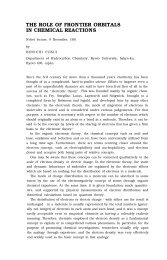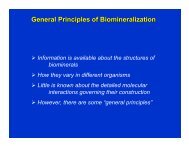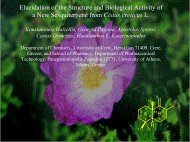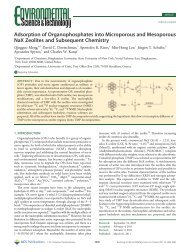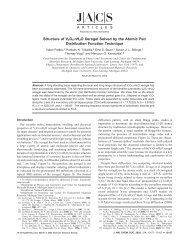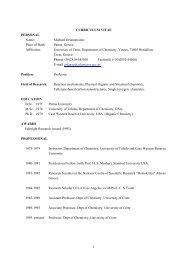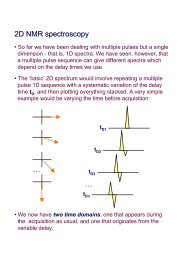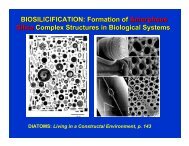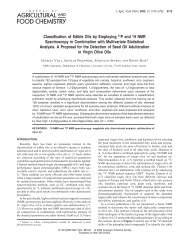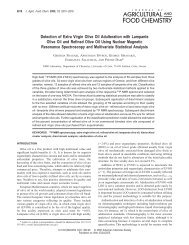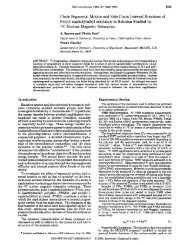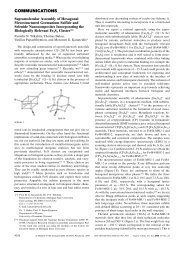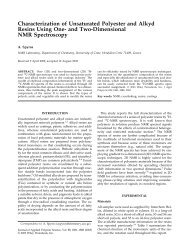Humic Acids: Marvelous Products of Soil Chemistry - Department of ...
Humic Acids: Marvelous Products of Soil Chemistry - Department of ...
Humic Acids: Marvelous Products of Soil Chemistry - Department of ...
Create successful ePaper yourself
Turn your PDF publications into a flip-book with our unique Google optimized e-Paper software.
Figure 4. a: β-O-4 lignin building blocks (31).<br />
b: Proposed “TNB” HA building block (32).<br />
c: Hollow elliptical helix obtained by linking<br />
lowest-energy TNB HA building blocks (32).<br />
d: Proposed 3-dimensional HA molecule. Note<br />
the predicted cavities for solute and water<br />
binding (reproduced by permission from ref<br />
34).<br />
(28). Highly aromatic HAs are more compact. At higher pH,<br />
time-dependent disaggregation and molecular stretching on<br />
dissociation <strong>of</strong> acidic groups decreases D owing to negative<br />
charge repulsion (29).<br />
HA Formation and Structures<br />
As revealed by their 13 C NMR spectra, HAs isolated from<br />
plants tend to be more aliphatic than those from soils. This<br />
suggests that HA formation from plants is completed in the<br />
soil (14). Humification is an oxidative process that includes<br />
aromatization and condensation reactions in the soil environment.<br />
Major pathways <strong>of</strong> HA synthesis in soils involve<br />
enzymatic and abiotically catalyzed free radical and condensation<br />
reactions, phenolic oxidative coupling, demethylation,<br />
and functional group oxidation <strong>of</strong> plant polyphenols, which<br />
occurs in leaves primarily in the fall (6, 30). Humification<br />
probably is catalyzed by microorganisms on clay and mineral<br />
surfaces, where life may have begun (2).<br />
The HA products are heterogeneous in three respects.<br />
First, they are made from different feedstocks. Second, they<br />
may be contaminated with sorbed lipids, nucleic acids, polysaccharides,<br />
proteins, steroids, clays, minerals, and metals. The<br />
pre-extraction with benzene–methanol in Figure 2 lessens this<br />
possibility. Third, they contain functionalized aliphatic–<br />
aromatic backbones that may be neutral, acidic, or basic and<br />
have low or high molecular weight.<br />
Consistent analytical and other properties encourage<br />
modeling <strong>of</strong> HAs. The first kind <strong>of</strong> model envisions the<br />
“average” HA building block and the second models the<br />
whole SOM. One HA building block (Fig. 4a [31]) comes<br />
from conversion <strong>of</strong> lignins and tannins; the other pathway is<br />
biosynthesis from amino acids (32). Lignin also is biosynthesized<br />
from amino acids. Actually, the so-called Temple–<br />
Northeastern–Birmingham (TNB) building block (Fig. 4b<br />
[14, 18, 32]) can be generated in known reactions from<br />
a b<br />
c<br />
<strong>Chemistry</strong> for Everyone<br />
known lignin components as suggested in Figure 5 (33). The<br />
proposed building blocks all have chiral centers and link<br />
together to give hollow helical structures that normally are<br />
filled with water (Fig. 4c). Random-coil HA behavior was<br />
deduced from frictional ratios in ultracentrifugation data (23).<br />
Thus, the helical model accounts for water retention by HAs<br />
in terms <strong>of</strong> their hollow centers and many hydrophilic functional<br />
groups on the outside <strong>of</strong> the secondary structure.<br />
The whole SOM model in Figure 4d (34) consists <strong>of</strong><br />
substituted benzene rings linked by long aliphatic chains in<br />
a molecule with M w ≈ 5 kDa. The structure has cavities large<br />
enough to accommodate peptides, small polysaccharides,<br />
water, and other solutes. The building blocks and wholemolecule<br />
HA models are mass fractals because <strong>of</strong> their “holes”.<br />
Whatever their structures, the fact is that HAs are excellent<br />
sorbents because they are hydrophilic, hydrophobic, and<br />
functionalized. This qualifies them as amphiphiles (6 ) that<br />
lower the surface tension <strong>of</strong> water and form micelles that can<br />
sequester hydrophobic molecules such as pyrene, adsorb more<br />
polar compounds, and bind metals. Another great gift <strong>of</strong> their<br />
versatility is that solid HAs behave as free-energy buffers (35).<br />
HO<br />
oxidation<br />
JChemEd.chem.wisc.edu • Vol. 78 No. 12 December 2001 • Journal <strong>of</strong> Chemical Education 1611<br />
O<br />
d<br />
oxidation and<br />
demethylation<br />
OCH3 HO HO OH<br />
oxidative<br />
demethylation<br />
and ring cleavage<br />
OH<br />
OCH 3<br />
Figure 5. Conversion <strong>of</strong> a lignin unit toward a TNB HA building block.<br />
HO<br />
OH<br />
oxidation<br />
oxidative<br />
demethylation<br />
OCH 3<br />
OH




